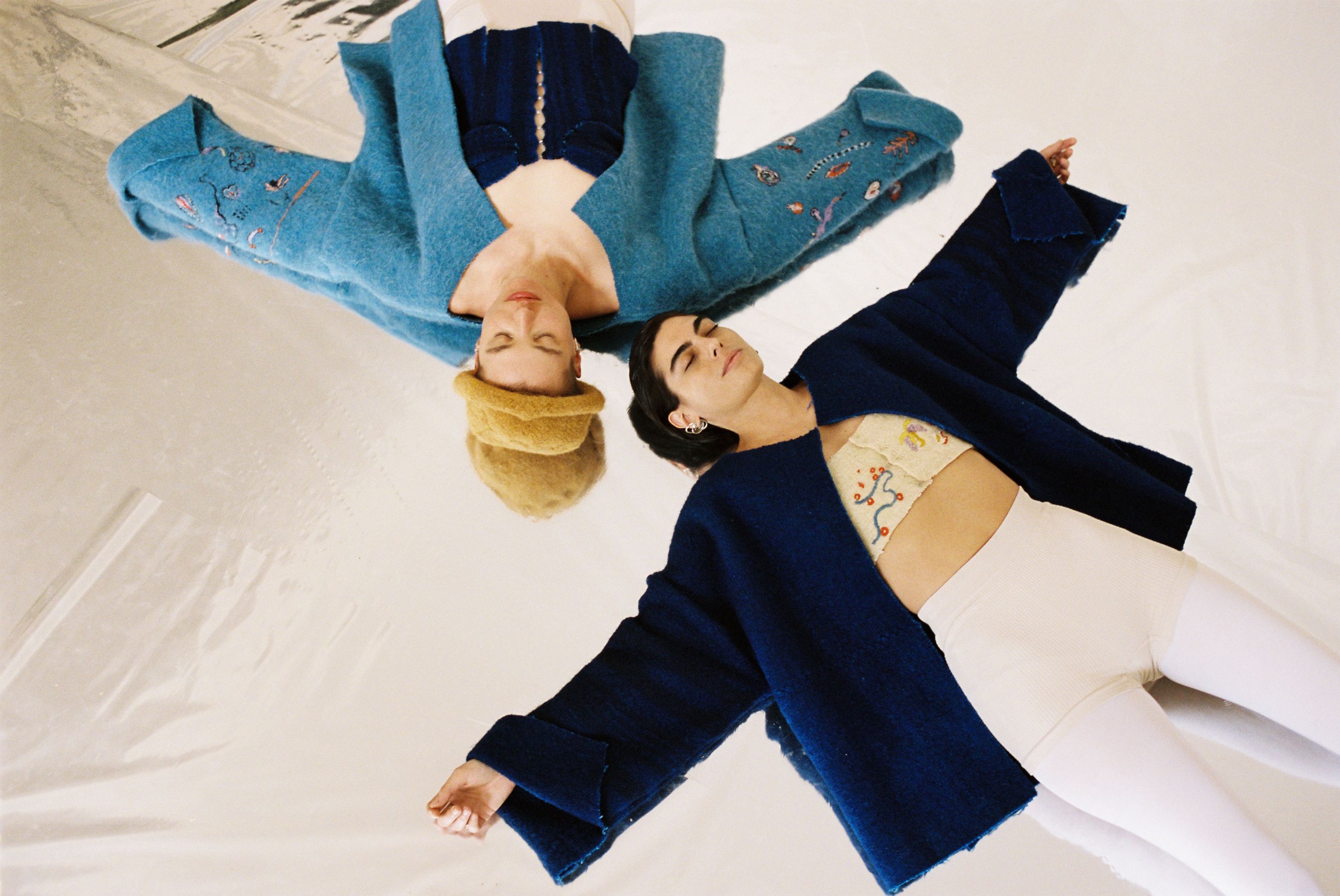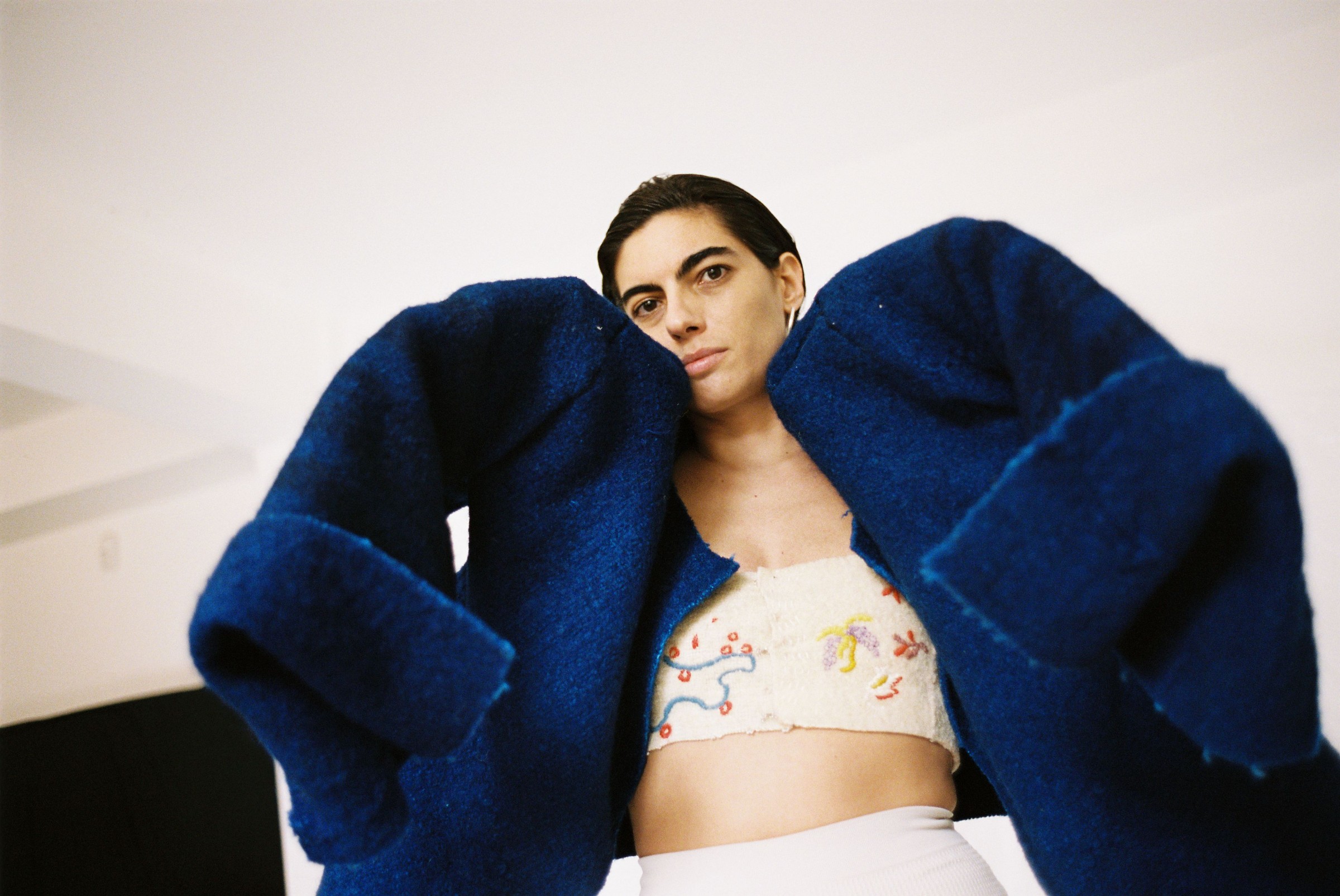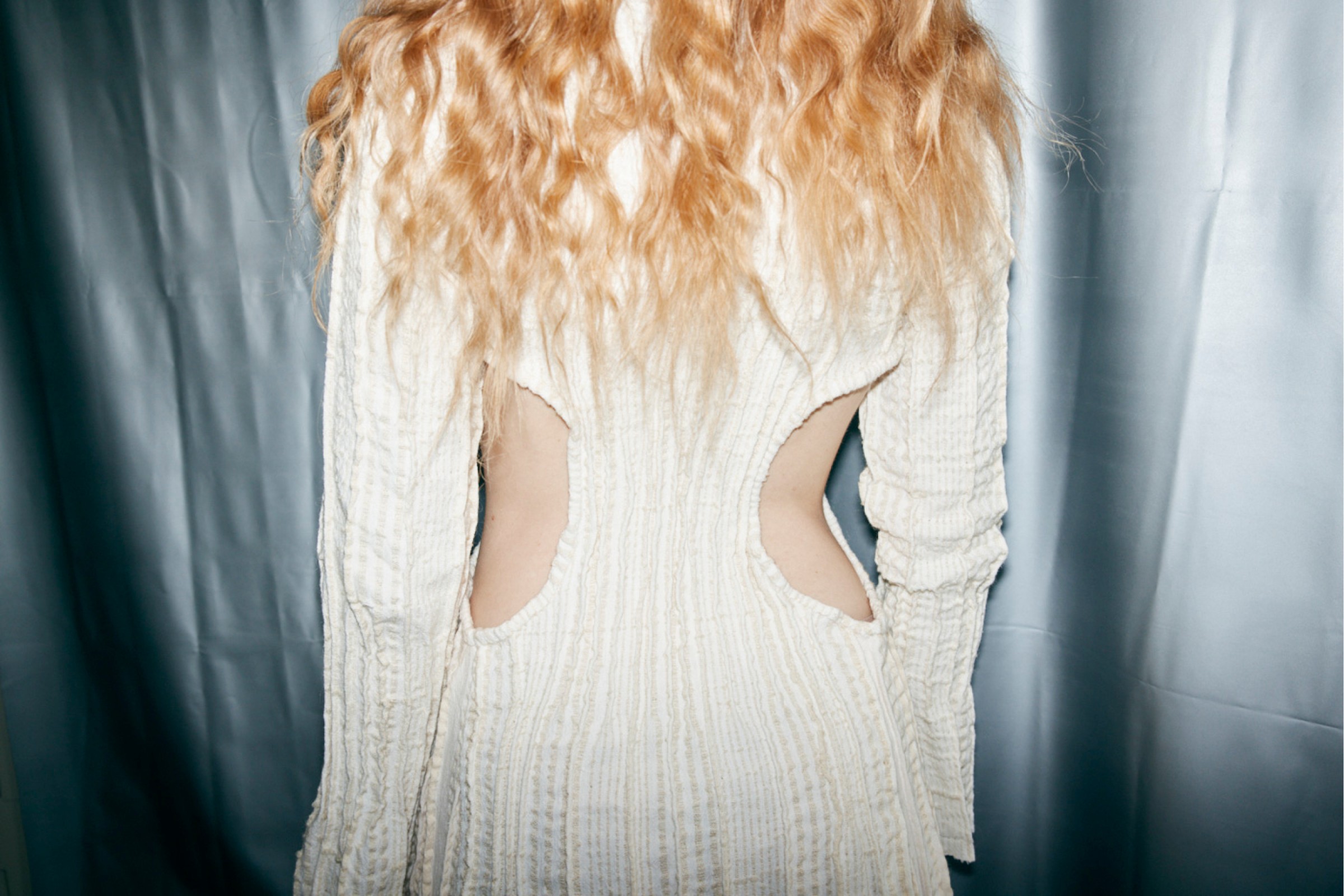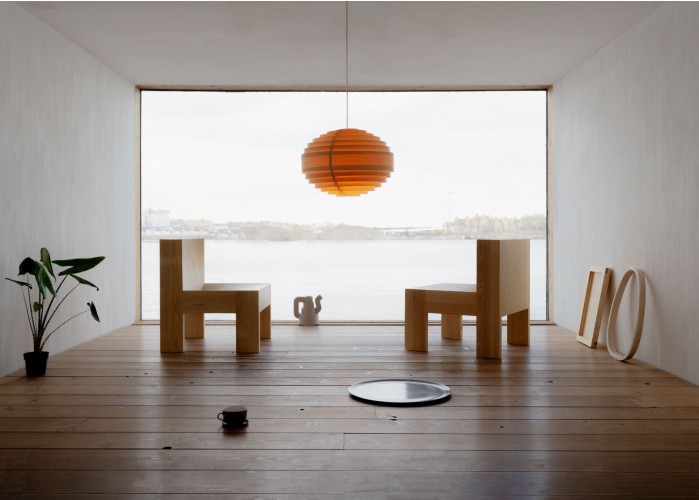Unsung Weavers: "Δίνουμε τη δική μας προσωπική ερμηνεία και μεταφράζουμε την ελληνική κληρονομιά"
DS.WRITER:
Σοφία Θρουβάλα
Οι Unsung Weavers θέτουν σε νέα πλαίσια τη μεταμόρφωση ιστορικών υλικών, ενεργώντας σαν μεσάζοντας στη διαχρονική συνεργασία μεταξύ των ανθρώπινων και μη-ανθρώπινων στοιχείων της φύσης. Η Unsung Weavers είναι μια σειρά από μοναδικά ρούχα, φτιαγμένα στο χέρι από μάλλινες κουβέρτες που έχουν διασωθεί από χωριά της Μεσογείου. Κάθε μοναδικό κομμάτι αποτελεί από μόνο του ένα ρέλι, απηχώντας τις από καιρό ξεχασμένες τελετουργίες της αγροτικής παραγωγής, ενώ αναβιώνει την αρχαία τέχνη της υφαντικής. Κάθε ρούχο είναι εξ ολοκλήρου ραμμένο στο χέρι από ένα μοναδικό μοτίβο που βασίζεται σε χρηστικά αρχέτυπα ενδυμάτων, όπως το πανωφόρι του βοσκού και το μοναστηριακό σακάκι. Υλικά συγκεντρωμένα στην Αρκαδία, σχέδια φτιαγμένα στην Αθήνα. Τα στριφώματα είναι ακατέργαστα, ενώ ορισμένα σχέδια διαθέτουν διακοσμητικό κέντημα στο χέρι. Τα παλτά δανείζονται τη μορφή τους από τις κουβέρτες που ήταν εμποτισμένες στην κοίτη του ποταμού για μέρες για να πάρουν μια πιληματοποιημένη υφή (felt), κάτι που τα καθιστά επίσης ανθεκτικά στο νερό.
Το νέο ελληνικό brand Unsung Weavers είναι παιδί της αρχιτέκτονα μηχανικού και σχεδιάστριας Ελίνας Τσελιάγκου και του σχεδιαστή και φωτογράφου Επαμεινώνδα Κούτσικου. Μαζί συγκεντρώνουν τα υφάσματα από τα μεσογειακά χωριά, με στόχο τον επαναπροσδιορισμό της ταυτότητάς τους σε "απτικά γλυπτά", το οποία εντυπωσιάζουν καθώς είναι ραμμένα στο χέρι με κεντημένες λεπτομέρειες και έντονα χρώματα. Μιλήσαμε μαζί τους σχετικά με την παράδοση και την έμπνευση από αυτή στον σύγχρονο σχεδιασμό ενδυμάτων. Πώς η επανάχρηση, όχι μόνο υλικών από την ελληνική ύπαιθρο αλλά και τελετουργικών, μπορεί να προσφέρει κάτι μοναδικό στο design;
Γιατί επιλέξατε το μαλλί ως υλικό «υπογραφής» σας;

Μια πολύ ιδιαίτερης υφής χειροποίητη μάλλινη κουβέρτα, ήταν από τα πρώτα υλικά που συναντήσαμε και αρχίσαμε να συλλέγουμε με εμμονή. Μας ενθουσίασε το γεγονός ότι ήταν αποτέλεσμα μιας πολύ μακράς διαδικασίας: αυτά τα υφάσματα για πρώτη φορά υφάνθηκαν στο χέρι, σε μικρούς οικειακούς αργαλειούς (στις περισσότερες περιπτώσεις η διαδικασία περιελάμβανε πρώτα τη δημιουργία του νήματος για την ύφανση, το ντύσιμο του μαλλιού με το χέρι και τη βαφή του). Έπειτα μουλιάστηκαν στην κοίτη του ποταμού για μέρες, και αυτό τους έδωσε αυτή τη χαρακτηριστική αδιάβροχη υφή τσόχας.
Σε αυτό το σημείο, αποφασίσαμε να χρησιμοποιήσουμε ως υλικά μας αποκλειστικά vintage ευρήματα ή αντίκες που κάποτε ήταν μέρος της προίκας των κοριτσιών. Αυτά τα υλικά έχουν μικρή ή καθόλου θέση στη σύγχρονη ελληνική κοινωνία. Τις περισσότερες φορές απορρίπτονται ως ξεπερασμένα, «βαριά», ή δύσκολα στο καθάρισμα και τη χρήση, σε σύγκριση με τα νέα, ελαφριά συνθετικά υλικά που κάποιος μπορεί απλώς να τα βάλει σε ένα πλυντήριο ρούχων.
Εμείς, από την άλλη, εκτιμήσαμε το γεγονός ότι ήταν «εκεί» και ότι ήταν το αποτέλεσμα μιας μακράς παράδοσης στη χειροτεχνία: τα περισσότερα από αυτά είναι φτιαγμένα από μαλλί που προέρχεται από τα ζώα των τεχνιτών, έχει βαφτεί με φυτά της περιοχής τους και πιληματοποιηθεί στα νερά τους. Μας έφεραν στο μυαλό την ανάμνηση μιας κοινωνίας που λειτουργούσε με εντελώς διαφορετικούς οικονομικούς όρους, μιας κοινωνίας που είχε ως βάση της τη Συμβίωση και που ήταν εναρμονισμένη με τις εποχές.
Έχετε μια ισχυρή σχέση με τη λέξη «παράδοση». Πώς σας εμπνέουν οι παραδοσιακοί τρόποι κατασκευής και γιατί;

Επιτρέψτε μας να πούμε ότι έχουμε έναν ισχυρό δεσμό με τις «παραδοσιακές» διαδικασίες παραγωγής υφασμάτων, αλλά διαφοροποιούμε τη στάση μας ως προς το σχέδιο του υφάσματος ή το εφαρμοσμένο μοτίβο κεντήματος κ.λπ. Αυτό που μας εμπνέει στους παραδοσιακούς τρόπους παραγωγής υφασμάτων, είναι ότι η κατασκευή υφασμάτων ήταν οικογενειακό ζήτημα. Ακολουθούσε έναν τελείως διαφορετικό ρυθμό από τους σύγχρονους της μαζικής παραγωγής. Ήταν μια παραγωγή με αργούς ρυθμούς, που λάμβανε υπ'όψιν της τους πόρους, με μια προσωπική σύνδεση μεταξύ του ατόμου που έφτιαξε το ύφασμα ή το ρούχο και το υλικό (ή την Ύλη) που το αποτελούσε. Οι διαδικασίες τους ακολουθούσαν αυτό που υπαγόρευαν οι εποχές, υποστήριζαν την αποκατάσταση, τη θεραπεία και τη συνεχή προσαρμογή.
Το Unsung Weavers αντιπροσωπεύει τα ίδια πράγματα. Οι διαδικασίες μας είναι παρόμοιας φύσης: όλα τα ρούχα μας είναι ραμμένα στο χέρι στο σύνολό τους, μερικά από αυτά φέρουν κεντήματα στο χέρι, ενώ οι βαφές που χρησιμοποιούνται είναι από φυτά που διαλέγονται με το χέρι από τους λόφους της Αττικής γύρω από το ατελιέ μας.
Ωστόσο, αυτό δεν είναι κάτι που κάνουμε ως ένα είδος τυφλής υποταγής στην παράδοση, αλλά ως τον μόνο τρόπο να συνδεθούμε σε προσωπικό επίπεδο με τις δημιουργίες μας. Η συλλογή μας αποτελείται από χειροποίητα υφάσματα που είναι εξαιρετικά ιδιαίτερα, με τις ατέλειες που έχουν όλα τα χειροποίητα κομμάτια. Αυτό, επομένως, απαιτεί μια μικρή, αργή παραγωγή. Ακόμα κι αν, σε ορισμένες περιπτώσεις, θα επιθυμούσαμε μια πιο «αυτοματοποιημένη», μεγαλύτερη παραγωγή, αυτό θα ήταν ασυμβίβαστο με τη δημιουργία μεμονωμένων κομματιών μοναδικής ταυτότητας, κάτι που εξακολουθεί να είναι η προτεραιότητά μας. Καθώς εργαζόμαστε πολύ με το μοντέλο “made to order”, πολλές φορές έχουμε στο μυαλό μας έναν συγκεκριμένο χρήστη, τον συγκεκριμένο σωματότυπο, τον χαρακτήρα και τις προτιμήσεις του.
Αλλά στις περιπτώσεις που η παράδοση σημαίνει μοτίβα κεντήματος ή πολύ συγκεκριμένα σχέδια υφασμάτων, τότε παρεκκλίνουμε. Θα λέγαμε ότι δίνουμε τη δική μας προσωπική ερμηνεία και μεταφράζουμε την ελληνική κληρονομιά ώστε να μπορεί να αρέσει σε έναν σύγχρονο διεθνή κόσμο.
Πώς γνωριστήκατε με την Αρκαδία, και τι έχει να προσφέρει αυτό το τόσο ιδιαίτερο, (σχεδόν) μυθολογικό μέρος στον σύγχρονο σχεδιασμό και την κατασκευή;

Τα πρώτα υφάσματα που συλλέξαμε προέρχονταν από αυτό το μαγικό μέρος. Μοιραία όμως, καθώς οι συλλογές μας μεγάλωναν και μεγάλωναν, αρχίσαμε να συλλέγουμε υφάσματα και από άλλες περιοχές της Ελλάδας.
Αυτό που μας τράβηξε εκεί, ήταν κυρίως το τοπίο και οι μύθοι που αντηχούν ακόμα σε αυτό το κομμάτι της Πελοποννήσου: λαμπερός ήλιος, τρεχούμενα νερά, πλατάνια που τιμούνται ακόμα σε πανηγύρια με πανσέληνο. Όσον αφορά τους μύθους, η περιοχή αυτή συγκεντρώνει στο συλλογικό υποσυνείδητο όλα όσα θεωρούμε σημαντικά: η Αρκαδία αντιπροσωπεύει την καταπράσινη φύση και τη Χώρα των πολλαπλών γεγονότων και υβριδίων. Οι μύθοι της αντανακλούν θέματα της ζωικής υπόστασης των ανθρώπων ή της ανθρώπινης φύσης των ζώων, τα οποία βρήκαμε όλα εξαιρετικά εμπνευσμένα.
Νιώσαμε ότι η Αρκαδία θα μπορούσε, ως σημείο αναφοράς, να βοηθήσει στην οικοδόμηση σχέσεων μεταξύ των ανθρώπων και άλλων ειδών, και θα μπορούσε να μας διδάξει -πέρα από τον άνθρωπο, το ζώο ή το φυτό- πόσο συνυφασμένοι είμαστε με το περιβάλλον μας.

Φωτογραφίες: Νώντας Κούτσικος





.jpg)
 (1).jpg)

